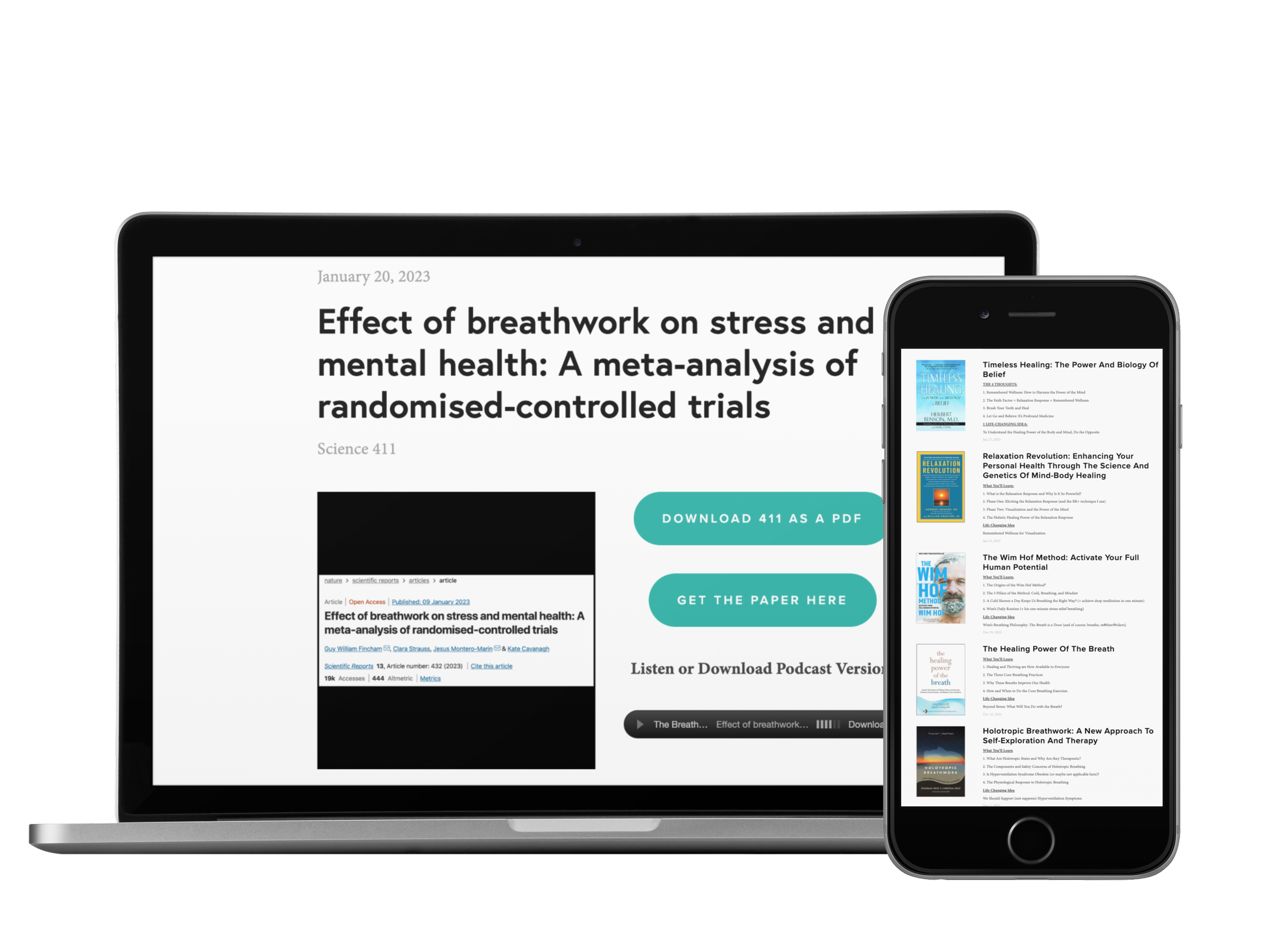Listen Instead of Reading
If you enjoy listening, you can subscribe to the audio version on Spotify, Apple Podcasts, and Audible so you don’t even have to look at the email 😊
4 THOUGHTS
1. Breathing to Reduce Negative Emotions
“In view of the close association between respiration, ANS activity, and emotions presented, it is apparent that individuals possess the ability to alter emotional states using the voluntary control of breathing and mindset.”
- Self-Regulation of Breathing as a Primary Treatment for Anxiety
Over the years, the most rewarding benefit of my breath practice has been better mental health. This paper helps explain why.
They propose that slow breathing alters cell excitability by activating the parasympathetic nervous system, making you physiologically less susceptible to negative emotions. That’s pretty neat.
If you’re interested, you can get all the details in the Learning Center.
***
P.S. To apply these findings in your life, consistently use virtually any slow breathing practice to activate the parasympathetic nervous system and increase overall vagal tone 🙏
2. How to Let Go: Brush Your Teeth and Heal
“Try to think of the practice as you would the daily ritual of brushing your teeth … Let your body heal itself without the interference of mind-generated doubts, criticism, and appraisals. … You wouldn’t critique your toothbrushing so don’t analyze this exercise either.”
- Herbert Benson, MD, Timeless Healing
Whether it’s breathing, meditation, or another wellness practice, a reoccurring theme I hear is that we need to let go of expectations. We need to simply perform the exercises without judgment. Judgment and self-appraisals will only take away from their healing potential.
That’s really easy to say, but harder to actually do. That’s why I love this analogy. Each time we find ourselves judging our practice, we can think: “You wouldn’t critique your toothbrushing so don’t analyze this exercise either.” Then, just get back to the practice.
Simple yet powerful 🙏
3. The Power of Breathing in Everyday Life
“[Breath] training not only results in extraordinary wisdom and realization…but it also results in ordinary worldly wisdom. When we have the qualities of calm and relaxation in body, speech, and mind, we are able to accomplish more, and with better-designed plans. We make clear and thoughtful decisions and have more harmonious relationships. We avoid doing things that are at odds with our personal goals and integrity, and do not sabotage our own growth. We avoid making impulsive decisions, or speaking impulsive words, ones we may regret later. When we lack chaos on the inside, the world outside reflects our sense of inner harmony.”
- Anyen Rinpoche & Allison Choying Zangmo, The Tibetan Yoga of Breath
This is a perfect description of how a consistent breathing practice can help our everyday lives in meaningful (yet often immeasurable) ways 👏
4. Loving Life
To genuinely fall in love with life, fall in love with breathing.
***
P.S. I know that sounds cheesy (it even feels cliche writing it), but it’s absolutely true.
Breath is Life Learning Center
“Thank you for all that you share. As a newly qualified Breath Instructor this information is vital for my learning so that I can pass this knowledge to my students.”
- Nicola
$14.99/month or $149/year
1 Quote
“Waking up is becoming more alive. The aliveness that’s available to all of you is already here in this moment. It’s life in the form of breathing.””
1 Answer
Category: Breathing and Emotions
Answer: Contemplative practices like breathing, meditation, and yoga may influence emotions by increasing this neurotransmitter.
…
(Cue the Jeopardy! music.)
…
Question: What is GABA (gamma-aminobutyric acid)?
In good breath,
Nick Heath, T1D, PhD
“Breathing is the compound interest of health & wellness.”
* An asterisk by a quote indicates that I listened to this book on Audible. Therefore, the quotation might not be correct, but is my best attempt at reproducing the punctuation based on the narrator’s pace, tone, and pauses.
Sign Up For The Breathing 411
Each Monday, I curate and synthesize information from scientific journals, books, articles, and podcasts to share 4 thoughts, 1 quote, and 1 answer (like "Jeopardy!") related to breathing. It’s a fun way to learn something new each week.

